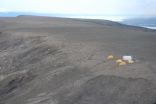(Press-News.org) Fabricating precise biomolecular structures at extremely small scales is critical to the progress of nanotechnology and related fields.
Traditionally, one of the ways this has been accomplished has been through the use of rubber stamps with tiny features — similar to those used by children in play, but detailed at the microscopic scale — which are covered with molecular "inks" and then stamped onto substrate surfaces, creating a molecular patterns. But when using this technique at the nanoscale, molecules tend to diffuse on the surface both during and after stamping, blurring the patterns.
To address this problem, researchers at UCLA have turned this conventional "soft lithography" process on its head: Instead of using a stamp to transfer molecules onto bare surfaces, they have used chemically treated stamps to remove molecules already in place on gold substrates, essentially peeling away select molecules through chemical bonds to create precise patterns measuring just a few molecules across.
The new process, called chemical lift-off lithography (CLL), results in higher-resolution patterning and avoids the blurring problems of earlier techniques.
The findings are published Sept. 20 in the journal Science. The research was supported by the U.S. Department of Energy and the Kavli Foundation.
The stamp used in the new process is molded by using a "master" made with more sophisticated and expensive tools than those used in making rubber stamps for offices and children, but the stamps can be used over and over again. Between each use, they are simply reactivated by an oxygen plasma.
The chemical bonds formed at the stamp—substrate interface are sufficiently strong to remove not only molecules in the monolayers but also one layer of gold atoms from the substrate. This observation settled a long-running discussion over whether, for such monolayers, gold–gold bonds break more easily than molecule–gold bonds — they do, the researchers found.
The research team was able to fabricate a variety of high-resolution patterned features, and stamps were cleaned and reused many times with little feature deterioration. The remaining monolayer, they found, can act as a resist for etching exposed gold features. The backfilling of new molecules into the lifted-off areas enabled patterned protein capture, and sharp 40 nanometer chemical patterns were achieved.
Led by Anne Andrews and Paul Weiss, the UCLA team represents a collaboration among researchers from UCLA's California NanoSystems Institute, the Semel Institute for Neuroscience and Human Behavior at UCLA, and the departments of chemistry and biochemistry, materials science and engineering, and psychiatry and biobehavioral sciences.
Conventional nanolithographic patterning techniques, such as photolithography and electron-beam lithography, are expensive, time-consuming, require specialized equipment and instrumentation, and have limited capabilities for chemical patterning; here, they only need to be used for the fabrication of stamp master molds.
Once individual masters are produced, CLL is used for high-resolution, high-throughput, low-cost pattern fabrication. This method enables patterns to be transferred to underlying substrates, and multiple-stamping strategies can be used to produce high-fidelity nanometer-scale patterns on gold substrates, with the additional possibility of patterning different materials, such as silicon, germanium, platinum and graphene.
The patterns fabricated demonstrate that CLL not only transfers large-area, high-fidelity patterns, but the post–lift-off exposed gold areas are advantageous for producing multiplexed patterned surfaces for selective capture of biomolecules from complex mixtures.
###
The California NanoSystems Institute is an integrated research facility located at UCLA and UC Santa Barbara. Its mission is to foster interdisciplinary collaborations in nanoscience and nanotechnology; to train a new generation of scientists, educators and technology leaders; to generate partnerships with industry; and to contribute to the economic development and the social well-being of California, the United States and the world. The CNSI was established in 2000 with $100 million from the state of California. The total amount of research funding in nanoscience and nanotechnology awarded to CNSI members has risen to over $900 million. UCLA CNSI members are drawn from UCLA's College of Letters and Science, the David Geffen School of Medicine, the School of Dentistry, the School of Public Health and the Henry Samueli School of Engineering and Applied Science. They are engaged in measuring, modifying and manipulating atoms and molecules — the building blocks of our world. Their work is carried out in an integrated laboratory environment. This dynamic research setting has enhanced understanding of phenomena at the nanoscale and promises to produce important discoveries in health, energy, the environment and information technology.
For more news, visit the UCLA Newsroom and follow us on Twitter.
Researchers develop new 'stamping' process to pattern biomolecules at high resolution
2012-09-21
ELSE PRESS RELEASES FROM THIS DATE:
Advancing the treatment of trauma
2012-09-21
With traumatic injuries claiming almost six million lives a year, improvements in care, including in the challenging areas of brain and bone injuries, and haemorrhage, are urgently needed.
Leading medical journal The Lancet today published a series led by researchers and clinicians from the National Trauma Research Institute (NTRI), a collaboration between Monash University and Alfred Health, which notes the difficulties and charts the progress in improving three critical areas of trauma care.
Traumatic brain injury (TBI) is the leading cause of trauma-related deaths ...
'Kick-starting' male fertility
2012-09-21
Adding a missing protein to infertile human sperm can 'kick-start' its ability to fertilise an egg and dramatically increase the chances of a successful pregnancy, a team of Cardiff University scientists have uncovered.
The team from Cardiff University's School of Medicine first found that sperm transfers a vital protein, known as PLC-zeta (PLCz), to the egg upon fertilisation. This sperm protein initiates a process called 'egg activation' which sets off all the biological processes necessary for development of an embryo.
Now, the team has found that eggs that don't ...
Nunavut's mysterious ancient life could return by 2100
2012-09-21
This press release is available in French.Global climate change means that recently discovered ancient forests in Canada's extreme north could one day return, according to Alexandre Guertin-Pasquier of the University of Montreal's Department of Geography, who is presenting his findings at the Canadian Paleontology Conference in Toronto today. "According to the data model, climate conditions on Bylot Island will be able to support the kinds of trees we find in the fossilized forest that currently exist there, such as willow, pine and spruce. I've also found evidence of ...
Nudge or think: What works best for our society?
2012-09-21
If approached in the right way, citizens are willing to change their behaviour and do more to help themselves and others, according to research funded by the Economic and Social Research Council (ESRC). The project, carried out jointly at the universities of Manchester and Southampton, experimented with different interventions techniqueswhich encourage citizen participation and explored people's motivations for community involvement.
The researchers focused on comparing the effectiveness of 'nudge' techniques, where people are offered incentives to change their behaviour, ...
Research blog: An expedition to the Earth's fiery heart
2012-09-21
Volcanic activity on and around La Réunion is driven by a localized upwelling of hot buoyant magma. Unlike most magma sources, this is not located on the boundary between two tectonic plates, and rises from much greater depths. It is a so-called hotspot, and has left behind on the overlying mobile crust a track of volcanic activity that stretches 5500 km northwards to the Deccan Plateau in India. Some 65 million years ago, in a process that had a massive impact on world climate, the Deccan area was covered with enormous amounts of lava as the Indian Plate passed over the ...
New challenges for ex-Olympians
2012-09-21
When elite-level athletes retire, they often struggle to adapt to their new lives. When finding that the characteristics that were valuable in sport are not equally useful in 'ordinary' life, they often start experiencing disorientation, depression, self-doubt or even illness. This is concluded in research from the University of Gothenburg.
Successful athletes at the elite level develop characteristics that should generate success also later in life. However, this notion may be wrong, according to the new research.
As part of a study, ex-Olympians from Sweden, Switzerland, ...
23 nuclear power plants are in tsunami risk areas
2012-09-21
The tsunami in Japan in March 2011 unleashed a series of negligence related with the resulting nuclear disaster. A scientific study headed by Spanish researchers has for the first time identified those atomic power plants that are more prone to suffering the effects of a tsunami. In total, 23 plants are in dangerous areas, including Fukushima I, with 74 reactors located in the east and southeast of Asia.
Tsunamis are synonymous with the destruction of cities and homes and since the Japanese coast was devastated in March 2011 we now know that they cause nuclear disaster, ...
Remarkable enzyme points the way to reducing nitric acid use in industry
2012-09-21
An enzyme in the bacterium that causes potato scab could help create new, environmentally-benign biocatalysts with the potential to cut use of the highly corrosive chemical nitric acid.
Chemists at the University of Warwick in the UK, in collaboration with researchers at Cornell University in the USA, have reported in the journal Nature Chemical Biology the discovery of an enzyme in the bacterium Streptomyces scabies that catalyses an aromatic nitration reaction.
TxtE, a cytochrome P450 enzyme, is the first example of an enzyme that has specifically evolved to catalyse ...
Swedish journalists to the left of the public and elected politicians
2012-09-21
On the political scale, Swedish journalists can be placed to the left of the Swedish public and their elected politicians. And the distance between the two sides has increased significantly in recent decades, although this is more due to the public and politicians having moved to the right than to journalists having moved to the left. These are the results of a study conducted at the University of Gothenburg, Sweden.
'The transition of journalists farther and farther to the left on the political scale stagnated in the mid-1990s,' says Professor Kent Asp, who headed the ...
Money key factor in driving med students from primary care careers
2012-09-21
Primary care physicians are at the heart of health care in the United States, and are often the first to diagnose patients and ensure those patients receive the care they need. But researchers from North Carolina State University, East Carolina University (ECU) and the Albert Einstein College of Medicine of Yeshiva University in New York have found that many students are choosing to pass up a career in primary care because those physicians make substantially less money than specialists, such as dermatologists or radiologists.
"We found that students who placed a premium ...

